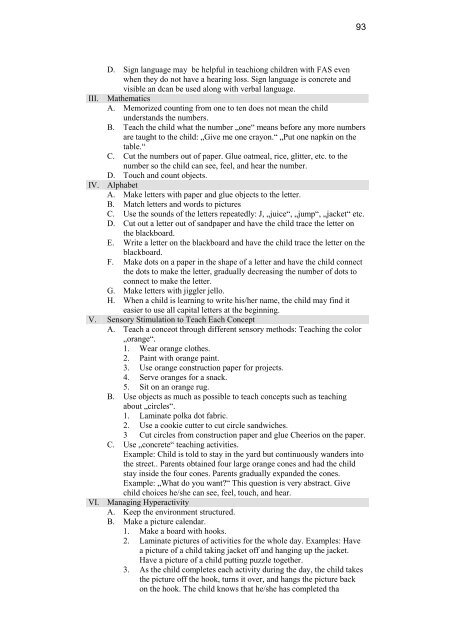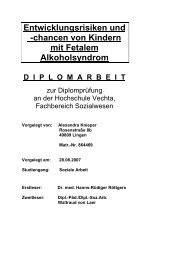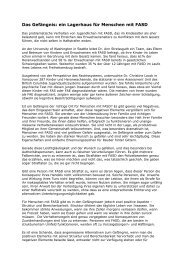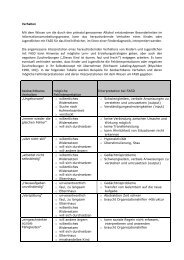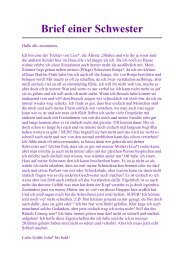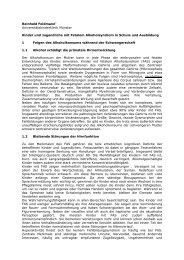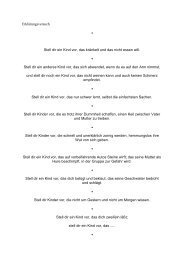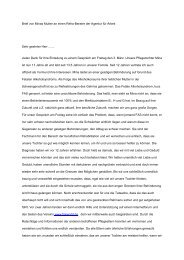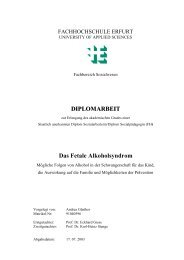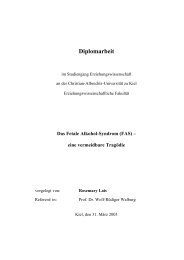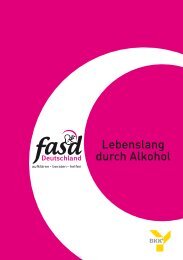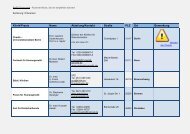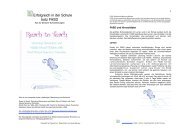Zum aktuellen Forschungsstand des fötalen Alkoholsyndroms von ...
Zum aktuellen Forschungsstand des fötalen Alkoholsyndroms von ...
Zum aktuellen Forschungsstand des fötalen Alkoholsyndroms von ...
Sie wollen auch ein ePaper? Erhöhen Sie die Reichweite Ihrer Titel.
YUMPU macht aus Druck-PDFs automatisch weboptimierte ePaper, die Google liebt.
D. Sign language may be helpful in teachiong children with FAS even<br />
when they do not have a hearing loss. Sign language is concrete and<br />
visible an dcan be used along with verbal language.<br />
III. Mathematics<br />
A. Memorized counting from one to ten does not mean the child<br />
understands the numbers.<br />
B. Teach the child what the number „one“ means before any more numbers<br />
are taught to the child: „Give me one crayon.“ „Put one napkin on the<br />
table.“<br />
C. Cut the numbers out of paper. Glue oatmeal, rice, glitter, etc. to the<br />
number so the child can see, feel, and hear the number.<br />
D. Touch and count objects.<br />
IV. Alphabet<br />
A. Make letters with paper and glue objects to the letter.<br />
B. Match letters and words to pictures<br />
C. Use the sounds of the letters repeatedly: J, „juice“, „jump“, „jacket“ etc.<br />
D. Cut out a letter out of sandpaper and have the child trace the letter on<br />
the blackboard.<br />
E. Write a letter on the blackboard and have the child trace the letter on the<br />
blackboard.<br />
F. Make dots on a paper in the shape of a letter and have the child connect<br />
the dots to make the letter, gradually decreasing the number of dots to<br />
connect to make the letter.<br />
G. Make letters with jiggler jello.<br />
H. When a child is learning to write his/her name, the child may find it<br />
easier to use all capital letters at the beginning.<br />
V. Sensory Stimulation to Teach Each Concept<br />
A. Teach a conceot through different sensory methods: Teaching the color<br />
„orange“.<br />
1. Wear orange clothes.<br />
2. Paint with orange paint.<br />
3. Use orange construction paper for projects.<br />
4. Serve oranges for a snack.<br />
5. Sit on an orange rug.<br />
B. Use objects as much as possible to teach concepts such as teaching<br />
about „circles“.<br />
1. Laminate polka dot fabric.<br />
2. Use a cookie cutter to cut circle sandwiches.<br />
3 Cut circles from construction paper and glue Cheerios on the paper.<br />
C. Use „concrete“ teaching activities.<br />
Example: Child is told to stay in the yard but continuously wanders into<br />
the street.. Parents obtained four large orange cones and had the child<br />
stay inside the four cones. Parents gradually expanded the cones.<br />
Example: „What do you want?“ This question is very abstract. Give<br />
child choices he/she can see, feel, touch, and hear.<br />
VI. Managing Hyperactivity<br />
A. Keep the environment structured.<br />
B. Make a picture calendar.<br />
1. Make a board with hooks.<br />
2. Laminate pictures of activities for the whole day. Examples: Have<br />
a picture of a child taking jacket off and hanging up the jacket.<br />
Have a picture of a child putting puzzle together.<br />
3. As the child completes each activity during the day, the child takes<br />
the picture off the hook, turns it over, and hangs the picture back<br />
on the hook. The child knows that he/she has completed tha<br />
93


